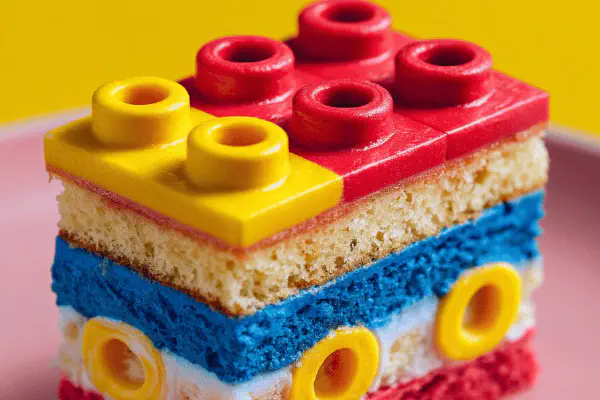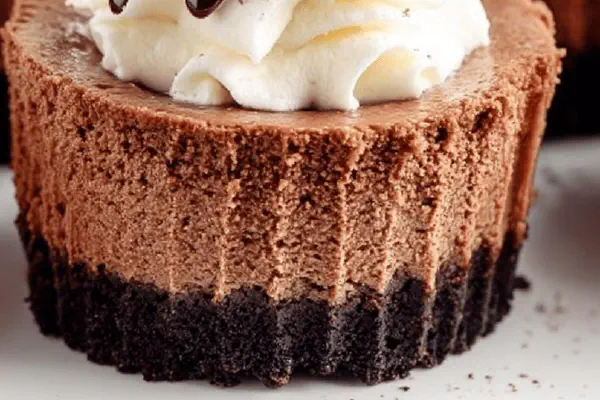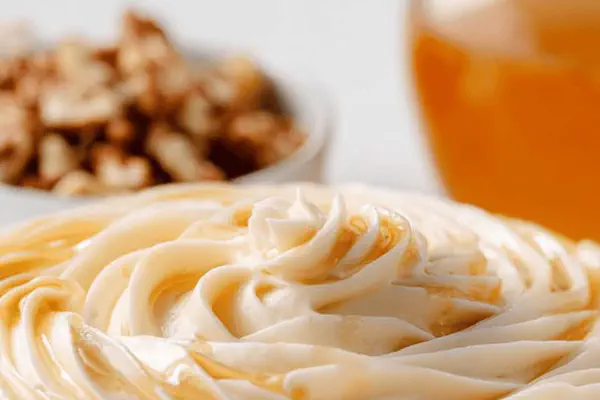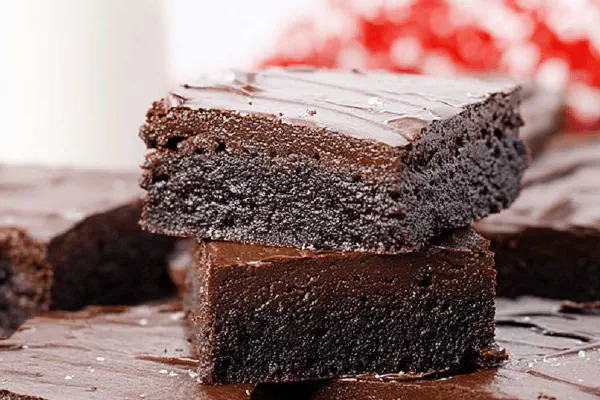Lego Block Cake

E
By Emma
Certified Culinary Professional
•
Recipe tested & approved
Yielding 14 to 16 portions, this layered cake relies on classic all-purpose flour replaced partially by cake flour for a lighter crumb. Baking powder softened to baking soda, quick fixes for rise and texture. Vanilla switched to almond extract, bringing unexpected warmth. Butter swapped for half margarine, easier handling in humid kitchens. Steps shuffled; baking times nudged 35 to 48 minutes. Three rectangular pans shape the cake blocks. Frosting splits into three colors—red, blue, yellow—gel dyes for vibrant Lego tone. Circles cut, thicker strip left for stamping. Cake assembly mimics Lego bricks stacked at angles on board. Texture and timing cues stressed over exact minutes. Practical tips on ingredient swaps and frosting fixes included.
Prep:
45 min
Cook:
48 min
Total:
Servings:
14-16 servings
#dessert
#layered cake
#colored frosting
#almond flavor
#baking tips
Started with the classic cake mix, got fiddly, so swapped flour types because all-purpose just too dense sometimes. Baking powder’s temperamental; baking soda gave a more consistent rise but watch the balance or your cakes will spike or flop. Almond extract surprised me—warmer than vanilla, less expected. Tried margarine for half the butter to keep spreadability; note big difference in texture. Frosting—don’t underestimate proper beating and slow powder sugar addition. Colors come alive best with gels; liquids water down everything, one disaster to last memory. Shaping cakes into Lego is more art than science; edges don’t need surgical precision. Play with stacking; fridge time helps set but not ice solid. Timing? Smell your kitchen, watch texture. Ignore the clock sometimes. Scraps useful for crumbs or quick snacks, no wasting here.
Ingredients
- 930 ml (3 3/4 cups) all-purpose flour sifted, replace 250 ml (1 cup) with cake flour
- 12 ml (2 1/2 tsp) baking soda instead of baking powder
- 1 ml (1/4 tsp) salt
- 280 ml (1 1/4 cups) unsalted butter softened, plus 95 ml (1/3 cup) margarine
- 720 ml (3 cups) granulated sugar
- 6 large eggs
- 15 ml (1 tbsp) almond extract instead of vanilla
- 360 ml (1 1/2 cups) whole milk
- For icing
- 560 ml (2 1/4 cups) unsalted butter softened
- 12 ml (2 1/2 tsp) almond extract
- 1.5 litres (6 cups) powdered sugar
- Gel food coloring: red, blue, yellow
About the ingredients
Swapping out 1 cup of all-purpose flour for cake flour lightens the crumb significantly—learned this after dense troughs in trial cakes. Using baking soda instead of powder needs balance with acidity elsewhere; trust your instincts on batter texture. Butter and margarine blend balances flavor with easier spreadability, especially in warmer kitchens. Almond extract steadies flavor profile, subtle but noticeable. Milk kept whole fat for moisture, swap for buttermilk or yogurt to tweak moisture and tang. Gel food coloring is a must—liquid dulls color and ruins frosting consistency. Keep colors separate to avoid muddy tones. Powdered sugar sifted to avoid lumps. Always prep pans well; cakes stick and ruin edge cuts otherwise.
Method
Cake
- 1. Center rack in oven; heat to 175°C (350°F). Grease and flour three loaf pans, 23 x 13 cm (9 x 5 in).
- 2. Whisk together all-purpose and cake flour, baking soda, and salt; set aside.
- 3. In mixing bowl, beat butter and margarine with sugar until pale, fluffy, hint of graininess gone. Eggs added one at a time, fully incorporated, creates thick, ribbons falling off beaters. Stir in almond extract.
- 4. At low speed, alternate adding dry mix with milk, starting and ending with dry ingredients. Light batter; don’t overmix—stop when no streaks remain.
- 5. Pour batter evenly in pans, listen for slight batter settling sound. Bake about 35 to 48 minutes—insert toothpick; if crumbs stick, needs longer. Look for light golden top, bounce on touch. Cool 15 minutes in pans, then flip onto racks—room temp until fully cold.
- 6. Trim cakes flat, four rectangular blocks, keep edges neat but not painful perfection. Cut a strip about 1.5 cm (1/2 inch) thick along one edge. Use 2.5 cm (1 inch) round cookie cutter to cut 16 circles from the strip; these become Lego studs.
- 7. Save scraps for snacking or crumbs in ice cream.
Frosting
- 8. Beat butter till creamy, add almond extract. Gradually add powdered sugar, low speed to avoid flour clouds, increase speed once combined till smooth, light, and spreadable. Divide into three bowls.
- 9. Add gel colors sparingly, mix: one red, one blue, one yellow; adjust shade by small increments. Keep colors vivid, not muddy.
- 10. Frost each cake block with different color using offset spatula. Work quickly; thickness even but don’t obsess over edges. Texture slight peaks welcome.
- 11. Place two blocks side by side at an angle, rest third cake across joints forming a Lego brick shape. Arrangement should look playful, a hint off-perfect alignment adds life.
- 12. Pipe or spread frosting onto each cut circle. Press gently onto cake blocks. Circles act as Lego bumps holding the visual together.
Serving & Tips
- 13. Chill briefly for firmer set, but serve near room temp to let buttercream melt slowly on tongue. Store wraps tight to avoid drying. Cracking frosting? Warm spatula slightly for fixes.
- 14. If cake seems dense, next attempt reduce margarine or mix in sour cream for moisture. Almond extract can be swapped back to vanilla, though this twist gives depth.
- 15. Cake flour replacement softens texture; if none, use all-purpose but expect a sturdier crumb.
- 16. Food coloring gel beats liquid for intense colors without softening frosting.
Cooking tips
Cake batter should be thick but flow easily; overmixing toughens gluten, undermining tenderness. Alternate wet and dry ingredients, starting/ending with dry, to distribute moisture evenly. Bake until tops bounce under light finger touch and toothpick comes out clean or with moist crumbs, never wet batter. Cooling in pans briefly helps cake release and keeps shape; flipping onto racks finishes the job. Cutting straight edges crucial for neat Lego blocks but total perfection unnecessary; rough edges mimic real bricks’ imperfections. Frosting temperature key—too cold, chunky; too warm, runny. Add sugar gradually while beating at low speed to maintain smoothness. Coloring in small increments prevents overkill. Assembling blocks at slightly off angles adds charm and realism. Frost little circles thickly to mimic Lego studs; patience here pays off. Cracking frosting? A warm spatula smooths it out. Store covered but at room temp to avoid drying or sweating.
Chef's notes
- 💡 Swap 1 cup all-purpose flour for cake flour; crumb gets lighter. Watch batter—overmix makes tough texture fast. Use baking soda instead of powder; acidity balance matters, no runaway rise.
- 💡 Butter plus margarine for mix: half butter, half margarine softens handling, especially humid kitchens—texture changes, spreads easier, flavor shifts subtle but notable.
- 💡 Gel food colors beat liquid; liquid dulls frosting, messes consistency. Add colors tiny bits at a time, keep shades vivid, no muddy blends. Work fast, frosting dries or cracks if overhandled.
- 💡 Cut cake blocks neat but rough edges fine; Lego bricks aren’t perfect. Trim to flat tops, cut strip for studs. Use 1 inch round cutter for Lego bumps—press frosting on thickly, texture counts.
- 💡 Bake 35-48 mins, trust bounce to finger and toothpick test over timer. Cool 15 mins in pan to settle shape, flip out for full cool. Chill frosting blocks briefly, serve near room temp so buttercream melts on tongue.
Common questions
Best flour for crumb lightness?
Cake flour subs lightens texture; all-purpose heavy but ok. Tried both, cake flour wins. Overmixing ruins softness though, keep batter tender.
Why baking soda over powder?
Baking soda reacts fast. Needs acid in batter balance or it spikes or falls flat. Adjust almond extract or milk acidity for rise management.
Frosting cracking, fix?
Warm spatula smooths cracks gently. Too cold frosting chunks up; too warm runs off. Sugar gradual adding key to smooth, beat low then high speed.
Storing Lego blocks?
Wrap tight, fridge not ideal—causes sweating. Room temp longer keeps fresh, chilled firmer but frost can crack. Quick chill before serving best trick.



